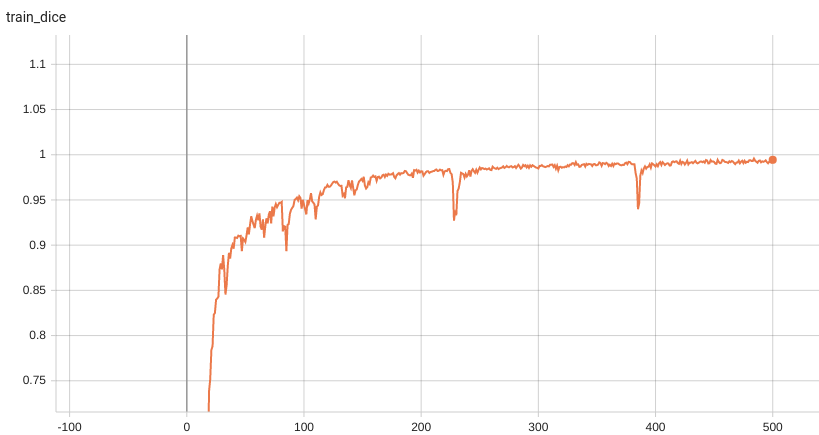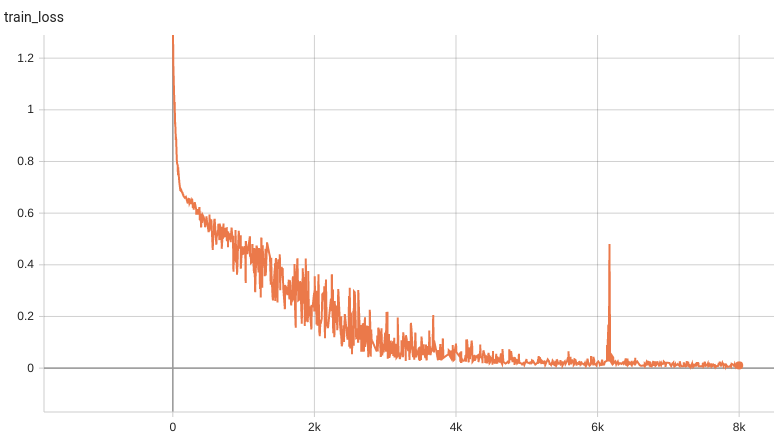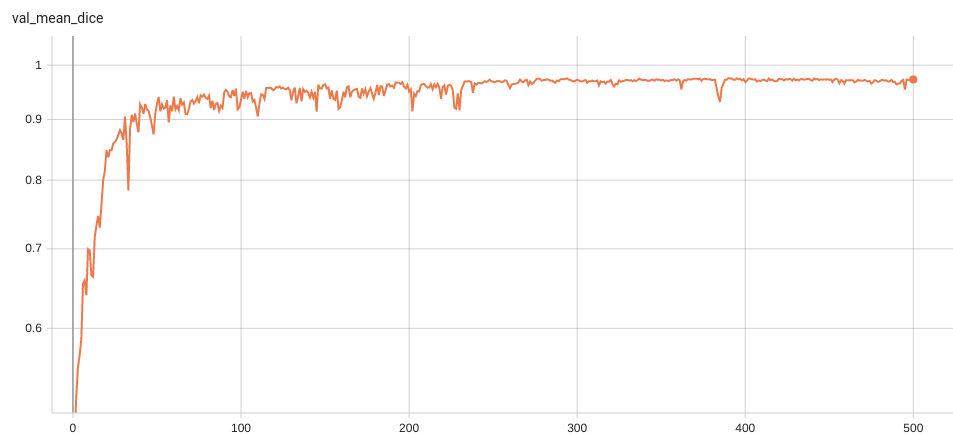This is a pre-trained model for 3D segmentation of the spleen organ from CT images using DeepEdit.
DeepEdit is an algorithm that combines the power of two models in one single architecture. It allows the user to perform inference as a standard segmentation method (i.e., UNet) and interactively segment part of an image using clicks [2]. DeepEdit aims to facilitate the user experience and, at the same time, develop new active learning techniques.
The model was trained on 32 images and validated on 9 images.
Data
The training dataset is the Spleen Task from the Medical Segmentation Decathalon. Users can find more details on the datasets at http://medicaldecathlon.com/ .
- Target: Spleen
- Modality: CT
- Size: 61 3D volumes (41 Training + 20 Testing)
- Source: Memorial Sloan Kettering Cancer Center
- Challenge: Large-ranging foreground size
Training configuration
The training as performed with the following: - GPU: at least 12GB of GPU memory - Actual Model Input: 128 x 128 x 128 - AMP: True - Optimizer: Adam - Learning Rate: 1e-4 - Loss: DiceCELoss
Input
Three channels - CT image - Spleen Segment - Background Segment
Output
Two channels - Label 1: spleen - Label 0: everything else
Performance
Dice score is used for evaluating the performance of the model. This model achieves a dice score of 0.97, depending on the number of simulated clicks.
Training Dice

Training Loss

Validation Dice

TensorRT speedup
The spleen_deepedit_annotation bundle supports acceleration with TensorRT through the ONNX-TensorRT method. The table below displays the speedup ratios observed on an A100 80G GPU.
method
torch_fp32(ms)
torch_amp(ms)
trt_fp32(ms)
trt_fp16(ms)
speedup amp
speedup fp32
speedup fp16
amp vs fp16
model computation
147.52
40.32
28.87
11.94
3.66
5.11
12.36
3.38
end2end
1292.39
1204.62
1168.09
1149.88
1.07
1.11
1.12
1.05
Where: - model computation means the speedup ratio of model’s inference with a random input without preprocessing and postprocessing - end2end means run the bundle end-to-end with the TensorRT based model. - torch_fp32 and torch_amp are for the PyTorch models with or without amp mode. - trt_fp32 and trt_fp16 are for the TensorRT based models converted in corresponding precision. - speedup amp , speedup fp32 and speedup fp16 are the speedup ratios of corresponding models versus the PyTorch float32 model - amp vs fp16 is the speedup ratio between the PyTorch amp model and the TensorRT float16 based model.
Currently, the only available method to accelerate this model is through ONNX-TensorRT. However, the Torch-TensorRT method is under development and will be available in the near future.
This result is benchmarked under: - TensorRT: 8.5.3+cuda11.8 - Torch-TensorRT Version: 1.4.0 - CPU Architecture: x86-64 - OS: ubuntu 20.04 - Python version:3.8.10 - CUDA version: 12.0 - GPU models and configuration: A100 80G
Memory Consumption
- Dataset Manager: CacheDataset
- Data Size: 61 3D Volumes
- Cache Rate: 1.0
- Single GPU - System RAM Usage: 8.2G
Memory Consumption Warning
If you face memory issues with CacheDataset, you can either switch to a regular Dataset class or lower the caching rate cache_rate in the configurations within range [0, 1] to minimize the System RAM requirements.
MONAI Bundle Commands
In addition to the Pythonic APIs, a few command line interfaces (CLI) are provided to interact with the bundle. The CLI supports flexible use cases, such as overriding configs at runtime and predefining arguments in a file.
For more details usage instructions, visit the MONAI Bundle Configuration Page .
Execute training:
python -m monai.bundle run --config_file configs/train.json
Please note that if the default dataset path is not modified with the actual path in the bundle config files, you can also override it by using --dataset_dir :
python -m monai.bundle run --config_file configs/train.json --dataset_dir <actual dataset path>
Override the train config to execute multi-GPU training:
torchrun --standalone --nnodes=1 --nproc_per_node=2 -m monai.bundle run --config_file "['configs/train.json','configs/multi_gpu_train.json']"
Please note that the distributed training-related options depend on the actual running environment; thus, users may need to remove --standalone , modify --nnodes , or do some other necessary changes according to the machine used. For more details, please refer to pytorch’s official tutorial
.
Override the train config to execute evaluation with the trained model:
python -m monai.bundle run --config_file "['configs/train.json','configs/evaluate.json']"
Execute inference:
python -m monai.bundle run --config_file configs/inference.json
Export checkpoint to TensorRT based models with fp32 or fp16 precision:
python -m monai.bundle trt_export --net_id network_def \
--filepath models/model_trt.ts --ckpt_file models/model.pt \
--meta_file configs/metadata.json --config_file configs/inference.json \
--precision <fp32/fp16> --use_onnx "True" --use_trace "True"
Execute inference with the TensorRT model:
python -m monai.bundle run --config_file "['configs/inference.json', 'configs/inference_trt.json']"
References
[1] Diaz-Pinto, Andres, et al. DeepEdit: Deep Editable Learning for Interactive Segmentation of 3D Medical Images. MICCAI Workshop on Data Augmentation, Labelling, and Imperfections. MICCAI 2022.
[2] Diaz-Pinto, Andres, et al. “MONAI Label: A framework for AI-assisted Interactive Labeling of 3D Medical Images.” arXiv preprint arXiv:2203.12362 (2022).
[3] Sakinis, Tomas, et al. “Interactive segmentation of medical images through fully convolutional neural networks.” arXiv preprint arXiv:1903.08205 (2019).
License
Copyright (c) MONAI Consortium
Licensed under the Apache License, Version 2.0 (the “License”); you may not use this file except in compliance with the License. You may obtain a copy of the License at
http://www.apache.org/licenses/LICENSE-2.0
Unless required by applicable law or agreed to in writing, software distributed under the License is distributed on an “AS IS” BASIS, WITHOUT WARRANTIES OR CONDITIONS OF ANY KIND, either express or implied. See the License for the specific language governing permissions and limitations under the License.
Follow AI Models on Google News
An easy & free way to support AI Models is to follow our google news feed! More followers will help us reach a wider audience!
Google News: AI Models

